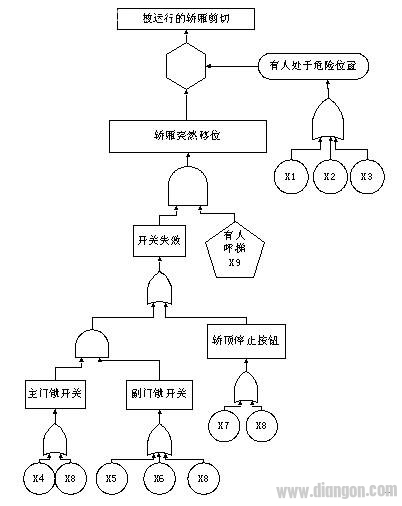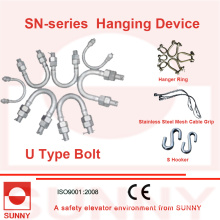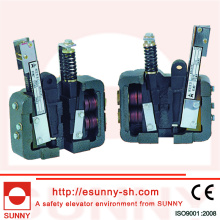Elevator inspection safety technology research and discussion - Database & Sql Blog Articles
2021-05-02
The general social activities and the process of production activities lurk the possibility of accidents. Therefore, in the process of elevator supervision and inspection, the hidden dangers of accidents are always accompanied by the whole inspection process. In order to prevent the occurrence of inspection accidents, in addition to the inspection of the elevator inspection procedures, the inspectors should fully understand and identify the potential hazards in the inspection process, so as to take corresponding measures to ensure the safety of the inspection process.
1. Identification of potential hazards in the elevator inspection process
Judging from the inspection items and contents stipulated in the "Elevator Supervision and Inspection Regulations", the elevators mainly have the following four forms of danger sources in the inspection process.
(1) Hazard source of fall injury accident
(2) Risk source of mechanical injury accident
(3) Risk source of electrical injury accident
(4) Other sources of injury accidents (such as poisoning, fire and explosion accidents, etc. in the inspection of toxic, hazardous and explosive places)
1.1, the source of danger of falling injury accident
Since the inspectors often carry out inspections at the top of the car and at the landing doors during the inspection of the elevators, the inspection process is prone to accidents involving falling from high places. For example, when the elevator door is opened with a triangular key, if the car is not at the landing and the inspectors are short, if the force is too large when opening the Landing Door, there is a possibility of falling into the hoistway. In the elevator inspection, the height is high. The risk of falling accidents is greater.
In the process of elevator inspection, the danger sources of high-level fall injury accidents are: (1) When conducting inspection and inspection during the installation process, when testing the track and other items, it is often carried out on the scaffolding, so there is a fall from the scaffolding. (2) Falling from the scaffolding or landing door when inspecting the landing door or landing door sill; (3) Falling from the door opening of the landing door and guardrail; (4) When inspecting the car roof, When crossing the upper beam, it falls from the hole formed by the wall of the hoistway and the car; (5) When the hall door is opened with a triangular lock, the station where the car is located is not observed, and the air is lowered to cause the height to fall.
1.2, the source of mechanical injury accidents
There are generally eight types of mechanical damage: biting, impacting, squeezing, bumping, pinching, shearing, cuts, and abrasions, jamming or tangling. In the elevator inspection process, the proportion of mechanical injury accidents is also quite large.
For example, when performing the verticality inspection of the traction sheave, the inspector will start the inspection if he forgets to stop the brake. When someone calls the elevator, the elevator suddenly starts, causing the inspector to have the possibility of being injured by the rotating traction sheave.
The source of accidents causing mechanical damage during the elevator inspection process is: when the vehicle is being tested, the rotating traction sheave and the moving Wire Rope may cause mechanical injury to the contactor; when the speed limiter is in motion speed verification, the finger has The possibility of being squeezed by the wire rope; when inspecting the brakes, rope grippers, etc., there is the possibility of being injured by moving parts such as rotation. When the inspector wants to enter the car roof from the hall door to carry out the inspection of the project in the hoistway, there is movement. The possibility of car cutting; when the inspector checks the pit or the car roof, if it is not in the position or improper operation, it may be squeezed by the moving parts such as the car. When the elevator is in operation test, if the car door is not locked or warned, it is possible that the passenger accidentally enters the car and causes a shear accident.
1.3, electrical injury accident source
Electrical injury is the damage caused by electrical energy to the human body. There are three types of electric shock, electromagnetic field damage and indirect damage. Electrical injury is most common with electric shock; indirect damage is not the result of electric energy, but the injury caused by a second accident such as a person falling or falling due to electric shock; electric shock has two forms: electric shock and electric shock. Accident statistics show that the vast majority of electric shock injuries are electric shock injuries. For example, during the elevator balance factor test, the elevator voltage and current are tested with a multimeter. Because of the live working, there is a possibility of electric shock without the insulated gloves.
In the process of inspection, the dangers of electrical injury accidents are as follows: 1. Electrical equipment and hand-held power tools do not meet the requirements of electrical safety regulations, that is, use unqualified products; 2. Electrical equipment and hand-held power tools are improperly used. Insulation damage causes the metal casing that is not charged under normal conditions to be charged, and because the leakage protection device is not installed or the operation is unreliable; 3, in the inspection process, the inspection is not strictly in accordance with the inspection specifications, illegal live working, etc., such as the elevator Grounding resistance test of the grounding system, the inspectors have no power failure, power inspection, and test without discharging large inductive and capacitive devices, there is the possibility of electric shock.
The identification of hazard sources is the key to making a correct prediction of accidents. It is necessary to adopt rigorous, reasoning and anti-pseudo-realistic attitudes and scientific means to comprehensively analyze faults (or accidents) from three major factors: human, machine and environment. And indirect reasons. Hazard sources can be analyzed using fishbone diagrams, fault tree analysis (fta), event tree analysis (eta), and fault hypothesis. For example, in the event of an accident that may occur during the gate inspection, the fault tree analysis (fta) is used for analysis, as shown in Figure 1.

Figure 1 Using the fault tree to analyze the risk factors of shearing by the car
X1-When the inspector opens the landing door with a triangular lock, the door lock is not verified, and some of the body is in the hoistway, such as the head reaching into the hoistway to observe the car position or the two legs crossing the car (top) and the landing door Between the hurdles.
When the X2-inspector is on the top of the car, if the stop switch is not pressed or the stop switch is not verified, the car top is placed, and the person's body is between the car top and the landing sill.
When the X3-inspector is at the top of the car, part of the body is between the car and the hoistway space.
Non-safe contact type electrical switch for X4, X5-main door lock and auxiliary door lock, contact sticking
X6- no auxiliary door lock
X7-Car top stop at the beginning of the contact sticking
X8-Maintenance personnel short the contacts of the damaged main or auxiliary door lock switch or car top stop switch
X9 - someone calls, this is a normal event
Selecting "cutting of the car being operated" is the top event of the fault tree. It occurs because of the "sudden shift of the car", but whether the person is cut depends on whether the inspector is in a dangerous position, such as When the inspector opens the landing door with a triangular lock, the head extends into the hoistway to observe the position of the car or the two legs straddle between the car (top) and the landing door sill. When the car suddenly starts, there is a possibility of being cut. Therefore, the control door is used between the top event and the first intermediate event, and the shearing accident occurs only when the person is in a dangerous position in the hoistway. The sudden shift of the car must have two factors at the same time, that is, the electrical switch that prevents the elevator from malfunctioning and the caller. Some people call the ladder. This is a normal event, so only the switch failure is further analyzed. When the contacts of the main and auxiliary door lock safety contact switches are short-circuited or the non-safe contact switches are used, the contact sticking will cause the switch to fail. Only when the main and sub-switches fail at the same time will the elevator start by mistake.
Through the in-depth analysis of the fault tree model, the structural importance, probability importance and key importance of each bottom event are obtained. From the perspective of three important degrees of analysis, the human factor plays a leading role, that is, the level of human technology and safety. In the contradiction between man and machine, man is the main factor of contradiction, that is, it is necessary to enhance the safety awareness and inspection operation skills of inspectors in order to prevent the occurrence of elevator inspection accidents.
2. Basic measures for accident prevention
Inspection work is a person, machine, and environmental system composed of personnel, equipment, and work environment. Therefore, taking measures to prevent accidents from these three aspects, and not causing these three unfavorable factors to occur at the same time, can avoid the occurrence of inspection accidents.
2.1 Putting the inspection environment off
Poor working environment can lead to human error, which leads to accidents. The bad inspection environment often causes accidents such as falling, falling from height, object striking, electric shock, etc. It is very important to check the environment for inspection safety. Article 8 of the "Elevator Supervision and Inspection Regulations" and Article 3 of gb10060 "Elevator Installation and Acceptance Specifications" respectively stipulate the inspection conditions and installation acceptance conditions for the implementation of on-site inspection, that is, the inspection site (mainly refers to the engine room, car roof, pit) Cleaning, there should be no items and equipment unrelated to the work of the elevator. Relevant sites should be placed with warning signs indicating that the inspection is in progress. These refer to the inspection and acceptance after the installation of the elevator. If the supervision and inspection of the installation process is carried out in the future, due to many civil works. The engineering and other equipment installation projects are still under construction. There are many construction units on site, and the environment is complex. The inspectors should pay more attention to environmental safety conditions, such as whether there are any debris in the doorway, whether the potholes are closed, and the layer door of the landing door is not installed. Whether it is surrounded by qualified fences, whether the scaffolding is in compliance with the requirements, etc.; whether the temporary power supply used for construction is installed according to the requirements of temporary power supply at the construction site, and whether it is equipped with a leak detection protection device.
For example, when the elevator track project is inspected during the installation process, the inspectors must stand on the decking of the scaffolding for inspection work, but often because the installation team saves trouble for the drawings, the scaffolding is not attached, especially the laying of the decking. The plywood of the elevator carton is used as a decking board. Because the shearing strength of the plywood is poor, the bending is easy to break and cause a falling accident. Therefore, the scaffolding that does not meet the requirements should be re-erected until the safety requirements are met.
When inspecting the guide rails and landings in the hoistway, in order to enable the inspectors to clearly see the surrounding conditions, the light should not be too dark or too bright to avoid accidents caused by poor lighting in the workplace, so install the elevator before installation. The unit first installs the hoistway lighting to ensure proper illumination in the hoistway.
2.2 Adhere to the work of warning and personal protection to prevent the occurrence of injury accidents
Warning signs must be set before inspection. Especially during regular inspections, people often take elevators. If warning signs are not set, passengers may mistakenly enter the car when performing linkage test such as Safety Gear and speed limiter or braking performance test. Causes shearing and other accidents. Because there are many elevator landings, especially high-rise elevators, it is impossible to set warning signs at each landing. I think that warning signs should be set at least in the car, at the base station and at the multi-station. .
When entering the inspection site, the inspectors must bring the “three treasures”, namely helmets, work shoes and seat belts. Especially in civil construction sites, there are often nails on the ground, so it is necessary to wear thick and non-slip work shoes. During the installation of the elevator, when entering the hoistway for the inspection of the track and bracket items, seat belts and helmets should be used. Before stepping on the scaffolding, the erection of the scaffolding should be checked, especially the working platform (paving), after stepping on the scaffolding. The inspector should try to stand on the paving plate near the cross frame and hang the seat belt rope on the safety rope or derrick in time. The length of the safety belt rope should not exceed 2m.
Some inspectors believe that it is wrong to wear a helmet only when entering the hoistway, and other places do not need to wear it. Because the elevators are inspected and inspected, often the civil works have not been completed, and many projects are still being carried out. It is not uncommon for pedestrians to fall and fall on the construction site because of the falling of objects from the heights. Therefore, every inspection personnel entering the site should be at any time. Wearing a hard hat.
2.3 The “Elevator Supervision and Inspection Rules” should be clearly defined and strictly enforced.
The inspector shall carry out the inspection according to the inspection method stipulated in the "Elevator Supervision and Inspection Regulations": "Elevator Supervision and Inspection Regulations" is an inspection outline, which mainly stipulates the contents and methods of the supervision and inspection of the elevator. It is summary and in the inspection. How to ensure the safety of inspection, what procedures should be carried out for inspection, and each inspection agency should be refined according to the "Elevator Supervision and Inspection Regulations", that is, the "Elevator Supervision and Inspection Rules" is formulated. The details of the rules shall include the inspection process, inspection methods, instruments used, safety precautions and safety precautions to be taken. Inspectors shall conduct inspections in strict accordance with the procedures and methods specified in the rules. The inspection procedure of the elevator is very important for inspection safety. If the inspection procedure is not correct, it may cause an accident. In addition to the clear overall inspection procedures for elevators, the Elevator Supervision and Inspection Rules shall also stipulate sub-procedures according to the risky branch projects, such as entering and exiting the car top inspection procedure, entering the pit inspection procedure and the dynamic load test inspection procedure. Wait.
To formulate the principle of the inspection procedure, I believe that it should be followed by the first table, first static and then move, first light and then heavy. For example, when the car carries 125% of the rated load, when the vehicle runs at the normal running speed, the motor and the brake are cut off, the car should be reliably stopped and there is no obvious deformation and damage. The test of the brake device and the test of the balance factor are rushed to carry out the heavy-duty brake test, which may result in a pier bottom accident due to insufficient braking force or insufficient traction capacity. Therefore, before doing heavy-duty braking performance test, first check the installation of the brake, check the contact area, clearance and braking torque of the brake wheel and brake shoe, measure the balance coefficient, and adjust the balance coefficient to 0.4 to 0.5.
2.4 Putting the verification off and eliminating the accident caused by the elevator defect
For example, when we want to go to the car top to carry out the inspection of the project in the hoistway, we must think that the safety switch of the door lock or the emergency stop switch of the car top may be invalid. Therefore, the reliability of the electrical switch must be verified before the top of the car, that is, we are at a certain landing. Outside the elevator, if the elevator runs from the lower level to the upper level, observe the indicator light of the landing station, and initially judge that the car top may have been higher than the 300mm position of the landing, use the triangular lock to open the landing door, and the elevator should stop running. When the emergency stop switch is pressed, the upper door is closed, the call is called again, and then the floor is opened. The car should remain in the original parking position, and it is verified that the electrical switch is reliable, and the inspector can hit the car top operation switch to the inspection state, and Turn on the car top lighting and then quickly enter the car top. This verification work is especially important for regular inspections of elevators, because it is often found in elevator inspections that elevator maintenance personnel are greedy and often short-circuit electrical switches.
2.5 Improve inspection conditions and adopt intrinsically safe inspection methods
At present, the inspection of the pit project, such as measuring the distance between the lowest point of the bottom of the car and the car buffer, requires the inspector to enter the pit, and then the car descends to the lowest level of the flat layer at the normal running speed, and the inspector uses steel. The tape measure measures the distance between the two, which presents the risk of being squeezed and sheared. For this reason, if we can use the remote sensing technology, we can do the elevator when the elevator is running, and the inspectors are not in the pit.
2.6 Prevention of electric shock accidents
2.6.1 When inspecting, firstly, the electrical insulation and grounding in the "Elevator Supervision and Inspection Regulations" shall be inspected to check whether there is any danger of leakage, insulation damage, etc. If the leakage and insulation damage are found, the inspection shall be stopped.
2.6.2 When carrying out electrical equipment work, the electrical operation rules of “blackout, power inspection, hanging signage, temporary grounding if necessary” shall be strictly observed, such as the grounding and insulation of items 2.11 and 2.22 of the “Elevator Supervision and Inspection Regulations”. During the test, when pulling down the elevator main power switch (air switch), first test with the electric pen on the main side of the switch, the electric pen is bright, verify that the electric pen is good, and then use the electric pen to switch the auxiliary three-phase live wire. Test separately, confirm that the three phases are no electricity, suspend the power card, and the inductor or capacitive load should be fully discharged before the test. When the test location is far away from the switch box, the temporary ground wire is also used to put the three live wires. Short.
2.6.3 Power tools are the main potential hazard sources that may cause electric shock accidents. Therefore, safe voltage type should be used for hand-held power tools. Measures to prevent electric shock should be taken when the rated voltage of power tools is higher than the safety circuit, such as speed limiter. When using the adjustable speed hand-held power tool during the speed check, the insulation must be checked. When using the power tool, always ensure effective grounding, or under the protection of the ground fault circuit breaker, or wear insulated equipment. Wait.
2.7 Prevention of mechanical injury accidents
2.7.1 Precautions for installing the elevator when the elevator is installed:
Before the test, the hoistway should be cleaned. Warning signs should be installed at the entrances of the halls and the cars to warn people to try the elevators. It is forbidden to enter the car. When there is no personnel in the hoistway, the car roof and the car, you can manually If you have a car, check if there is any jamming. After confirming the error, you can run the test run.
2.7.2 If it is necessary to work in the car roof or pit, it should be carried out under the condition that the safety of each limit safety device is checked and the car top operation button is given priority. And individuals should take emergency measures to prevent extrusion.
2.7.3 When detecting parts that may suddenly move due to external misoperation, there should be reliable measures to prevent the parts from moving during the test. For example, when detecting the verticality of the traction sheave, the elevator main power switch should be pulled down. Avoid someone calling the elevator and the elevator suddenly starts;
Items that must be tested during exercise, such as the detection of the running speed of the elevator, should be taken to prevent the shearing and squeezing of the moving parts. It is best to test one person, one person to guard, and not to wear gloves for testing.
3. Conclusion
Due to limited human cognition ability, sometimes the danger sources and their harmfulness in the system cannot be fully understood. Even if the existing danger sources are recognized, with the development of science and technology, new technologies, new processes, new energy, new materials and new The emergence of products will create new sources of danger. For the dangerous sources that have already been recognized, it is limited by many factors such as technology, capital, and personnel quality. It is impossible to completely eradicate them. Therefore, the goal of system security is to strive to control the source of danger, to minimize the possibility of serious accidents, or to cause the least number of casualties and property losses in the event of an accident. In general, three aspects should be done: first, organize relevant technical experts to formulate elevator supervision and inspection rules and safety manual for inspectors. Exploring the intrinsically safe inspection method; secondly, it is necessary to strictly follow the inspection procedures and inspection rules to ensure that the elevator inspection process is infallible; thirdly, each inspection personnel should establish a sense of safety self-protection during the inspection process. Wear personal protective equipment strictly.
|
OTIS Elevator Safety Gear, Thyssen Elevator Safety Gear, KONE Elevator Safety Gear, GiantKONE Elevator Safety Gear, ThyssenKrupp Elevator Safety Gear, Schindler Elevator Safety Gear, XJ Schindler Elevator Safety Gear, Xizi OTIS Elevator Safety Gear, Mitsubishi Elevator Safety Gear, Shanghai Mitsubishi Elevator Safety Gear, Fujitec Elevator Safety Gear, Hitachi Elevator Safety Gear, Toshiba Elevator Safety Gear, Hyundai Elevator Safety Gear, LG Elevator Safety Gear, Sigma Elevator Safety Gear, Express Elevator Safety Gear, GUANGRI Elevator Safety Gear, FUJI Elevator Safety Gear, BLT Elevator Safety Gear, CANNY Elevator Safety Gear, SJEC Elevator Safety Gear, KOYO Elevator Safety Gear, IFE Elevator Safety Gear
progressive type safety gear, progressive safety gear, gradual-clamp safety, gradual wedge clamp safety, car safety, car safety gear, car safety mechanism switch, flexible guide clamp safety, flexible wedge clamp safety, instantaneous safety, instantaneously type safety gear, instantaneously safety gear, wedge-clamp type safety, wedge type safety gear, equalizing rod, wedge shaped jaw, safety gear, catch block, safety reset hole, safety jaw, safety block, safety plank, stopping distance of safety, safety gear block, counterweight safety, roller type safety, captive roller safety gear, sliding type safety, gradual safety |
|
|
|
|
|
|
|
|
|
|
|
|
|
|
|
|
|
|
|
|
|
|
|
|
|
|
|
|
|
|
|
|
|
|
|
|
|
|
|
|
|
|
|
|
|
|
|
|
|
|
|
|
Elevator Safety Gear, Elevator Progressive Safety Gear, Elevator Safety Parts, Escalator Parts Safety Gear
Nova Elevator Parts Co., Ltd. http://www.zjelevatordoorsystem.com








